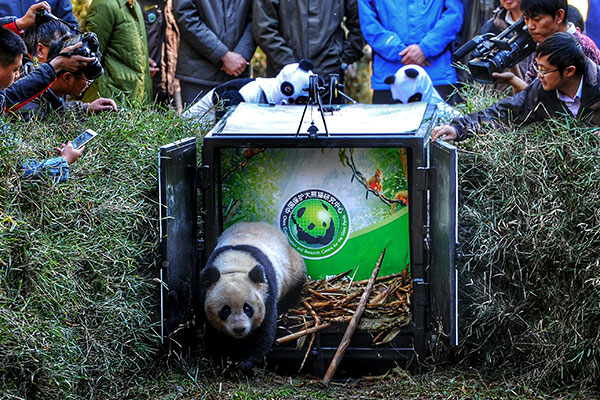
Hua Jiao, a 2-year-old female panda, is set free at the Liziping National Nature Reserve in Shimian county, Sichuan province, on Nov 19, 2015.[He Haiyang / for China Daily]
Hua Jiao, a 2-year-old female panda, was set free at Liziping National Nature Reserve in Shimian county, Sichuan province, on the afternoon of Nov 19.
“It marked the fifth time a captive panda has been released into the wild with the intention of enlarging the wild panda population,” said Zhang Guiquan, a veteran panda expert with the China Conservation and Research Center for the Giant Panda in Wolong, Sichuan.
The first panda released into the wild was Xiang Xiang, who was born in 2001. The male panda was released in Wolong in 2006. In 2007, its body was found in the woods, with broken ribs and injuries to its ears and back.
Researchers suspected it had taken refuge in a tree after fighting with wild pandas, but had fallen.
Its death forced handlers to revise their approach to training their pandas to survive in the wild.
When training Tao Tao, who was born in 2010, they approached the animal dressed in panda costumes that had been splattered with panda urine.
It became the second panda released into the wild in 2012.
A team of animal experts and local employees at Liziping found Tao Tao up a tree one year later.
A vet shot the frightened bear with a tranquilizer and it fell into a net set up by the team. A blood test showed the panda was in good health, said Yang Zhisong, team leader from China West Normal University in Nanchong, Sichuan.
After Tao Tao was released into the wild, researchers started choosing female pandas for introduction to the wild.
“Female captive pandas might be more easily accepted by wild pandas,” said Zhang Hemin, head of the Wolong research center.
In 2013, Zhang Xiang, a 2-year-old female panda, was released into Liziping. Although nobody has seen her since, researchers think she might be fine, Zhang Guiquan said.
But Xue Xue, the panda released into the wild last year, had a tragic end.
“Before it was released, the animal was placed in a cage for several days. It took about eight hours for the animal to reach Liziping from Wolong where it had lived,” said Zhang Guiquan.
“It was frightened by being put in a cage as well as the transportation process. It was found to have died of fear in the wild about 40 days later,” he said.
“Its death was a natural part of the experiment to release captive pandas into the wild, which is something unprecedented.”
But researchers in the center have reduced unfavorable human impact on Hua Jiao.
“We caged her on the morning on Nov 19 so that she would not stay captive for too long,” Zhang Guiquan said.
He said that his center might release another 2-year-old panda into the wild next April.
“Releasing captive pandas is a long-term task that will take much time to accomplish and our center has a plan for releasing a captive panda into the wild each year,” he said.
